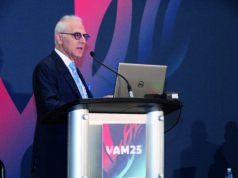This advertorial is sponsored by Tampa General Hospital.

Patients with complex pararenal and thoracoabdominal aortic aneurysm (TAAA) disease are faced with limited treatment options outside of one of the most technically and physiologically demanding operations on a vascular surgeon’s schedule: open repair.
With high morbidity (30–50%) and mortality (4–20%) rates associated with open repair, minimally invasive options via fenestrated/branched endovascular aneurysm repair (F/BEVAR) represent a safer alternative. But given the investigational nature of the endovascular devices used to treat patients with complex pararenal and TAAA pathology, access to these devices remains extremely limited to clinical device trials at certain medical centers and subject to Food and Drug Administration (FDA) restrictions.
The access problem is particularly magnified in the state of Florida, which is where Tampa General Hospital vascular surgeon, Dean Arnaoutakis, MD, steps in. Arnaoutakis recently acquired a physician-sponsored investigational device exemption (PS-IDE) from the FDA to study and perform F/BEVARs using physician-modified endografts (PMEGs) in a clinical trial setting—one of the limited pathways vascular surgeons can offer for this type of F/BEVAR repair.
Using PMEGs under the auspices of a PS-IDE trial is the only one of its kind in Florida. This opens up more members of the state’s sizable population who have complex pararenal and TAAA pathology to the prospect of an alternative to open repair, explains Arnaoutakis.

“I embarked on this mission because most of our patients with aortic disease, not surprisingly, are elderly, frail, and have underlying cardiopulmonary conditions,” he says. “The traditional open pararenal or thoracoabdominal repair is an incredibly morbid procedure and very poorly tolerated in this particular patient population.”
Florida is the third most populous state in the U.S. with a population of more than 21 million people, over 20% of whom are older than 65, Arnaoutakis points out. The percentage of elderly people in the state is projected to increase over the next decade. Given that aortic disease typically affects the elderly, the incidence of patients with aortic pathology in the state is relatively higher than other states. As a large tertiary referral center, Tampa General Hospital cares for a high volume of patients with aortic disease, many of whom have complex pathology. “For example, in the fiscal year 2020, our center saw 750 patients with aortic pathology in the outpatient setting and performed over 250 aortic operations,” Arnaoutakis, an associate professor in the division of vascular surgery at the University of South Florida College of Medicine, elaborates.
The process of being granted a PS-IDE clinical trial from the FDA in order to offer potentially safer repair options for these patients was lengthy, he notes. The application involved several rounds of both pre- and official submissions, taking nearly two years to complete.
Being able to offer a PMEG significantly broadens treatment options for patients in Florida, Arnaoutakis says, as access to off-the-shelf and/or custom-made devices through clinical trials is so limited. “There are no commercially approved F/BEVAR devices. Enrollment in the TAMBE [thoracoabdominal branch endoprosthesis] clinical trial, an off-the-shelf branched device, has been challenging at times due to the numerous yet necessary inclusion/exclusion criteria. Referring patients to one of the select centers with restricted access to custom-made devices is another option, but can be somewhat impractical. Most of my patients don’t have the financial means, family support, or wherewithal to travel long distances to see one of those surgeons.”
Until now.
“There’s certainly a need in our region to treat patients with complex aortic disease in an endovascular fashion. Once I realized that garnering access to custom-made devices through industry was going to be unrealistic in the short-term, I developed expertise in PMEGs. As my clinical volume of PMEGs increased, I recognized that it was most prudent for patient care to obtain an IDE from the FDA to examine the efficacy of these procedures.”











